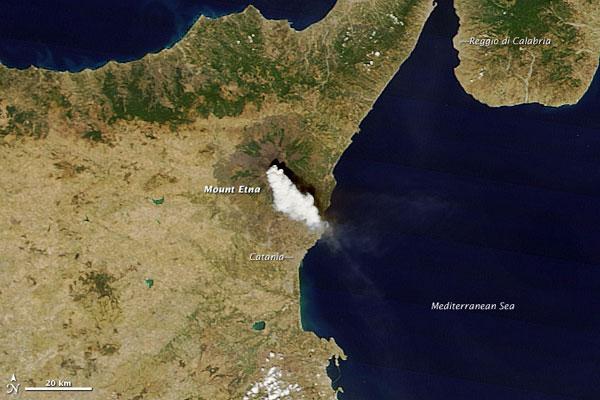Mt. Etna's Violent Bursts Spotted from Space

Throughout 2011, activity at Sicily's Mount Etna has been characterized by paroxysms: short, violent bursts of activity.
Each event has included volcanic tremors, ash emissions, and lava flows centered around the New Southeast Crater, just below the summit. On Aug. 12, Etna had its tenth paroxysm of the year, which was captured in a new natural-color image from NASA's Terra satellite. Etna spewed a thick white plume of gas and ash to the southeast, towards the nearby city of Catania.
The ash cloud was produced by vigorous lava fountaining at the New Southeast Crater. [See the Mt. Etna eruption photo from space]
The Toulouse Volcanic Ash Advisory Center estimated ash emissions reached an altitude of 14,000 feet (4,300 meters); 2,000 feet (600 meters) above the 10,925-foot (3,330-meter) summit.
Etna is the largest active volcano in Europe and one of the world's most well-known volcanic peaks. While 2010 was an exceptionally calm year for Etna, it is nearly constantly volcanically active and rarely a year passes without Etna erupting.
See all the latest action on the Etna's webcams.
This story was provided by OurAmazingPlanet, sister site to SPACE.com.
Breaking space news, the latest updates on rocket launches, skywatching events and more!
Join our Space Forums to keep talking space on the latest missions, night sky and more! And if you have a news tip, correction or comment, let us know at: community@space.com.
For the science geek in everyone, Live Science breaks down the stories behind the most interesting news and photos on the Internet, while also digging up fascinating discoveries that hit on a broad range of fields, from dinosaurs and archaeology to wacky physics and astronomy to health and human behavior. If you want to learn something interesting every day, Live Science is the place for you.

